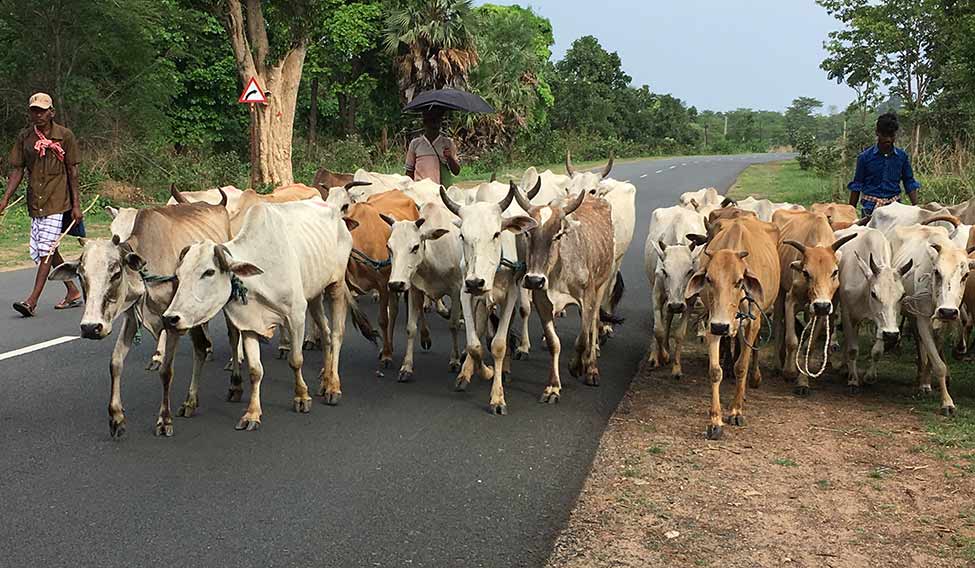Maharaja Krishna Kumarsinhji Bhavsinhji of Bhavnagar (an erstwhile princely state in the Saurashtra region) used to gift the famous Gir cows of Gujarat to Brazilian farmers in the 1900s. Little did he realise then that animal husbandry in India would suffer years later. The numbers of the desi Gir breed started dwindling and cross-bred Jersey cows took over. Now, Gir cows give a staggering yield of 73.3 litres of milk per day to Brazilian farmers and India is importing bull semen to revive them.
The Modi government has made it very clear that it takes cow protection seriously. Soon after coming to power in 2014, the government started the Rashtriya Gokul Mission to protect indigenous cattle breed. The latest notification—banning the trade of cattle at animal markets for the purpose of slaughter—came to be after sustained attempts involving many ministries.
Cow slaughter for beef has been giving sleepless nights to the government. In 2015, a proposal to rename a village called ‘Beef’ landed at the home ministry’s desk. The Hindu-dominated village was located near the Himalayan shrine of Yamunotri in Uttarkashi district of Uttarakhand. The ministry changed the British era name ‘Beef’ to Narayanpuri. In spite of tokens like this, cow vigilantism has been on the rise and the home ministry came under intense pressure. In 2016, Union Home Minister Rajnath Singh said there was a need for a law banning cow slaughter in the country. The human rights division in the home ministry, which deals with national integration and communal harmony, opposed any such move. The bureaucrats cited the federal rights of states to convince the home minister that the matter was purely a state subject.
Anil Madhav Dave, then environment minister, referred the matter to the Union agriculture ministry’s animal husbandry department (cattle division). Sources in the ministry conceded that regulation of livestock markets was a state subject and there was no way the agriculture ministry could interfere. “It could only be an advisory role. If the Centre actually wanted to legislate, we would have had to make a constitutional amendment,” a senior official said.
After many twists and turns and the activism of Union Minister Maneka Gandhi’s People For Animals, Dave signed the notification on the trade of cattle at animal markets for slaughter. Last month, the environment ministry came out with the Regulation of Livestock Market Rules, framed under the Prevention of Cruelty to Animals Act, 1960. None of the stakeholders like the ministries concerned or the departments dealing with the subject were consulted.
Former agriculture secretary S.K. Pattanayak told THE WEEK that restrictions on purchase and sale of buffaloes in cattle markets would affect farmers’ income and further limit their ability to replace unyielding, infirm and old animals.
Food and trade policy analyst Devinder Sharma questioned how the policy makers could ignore the fact that cows and buffaloes sustained the rural economy. He said it could be a ploy to open up the dairy sector to multinational companies.
“Cattle is a vital part of the rural economy. Today, we know there is an agrarian crisis and the farmers who are surviving are not dependent on crops alone. They are keeping dairy animals,” said Sharma.
According to the Economic Survey of 2016, the average annual income of a farmers’ family is Rs 20,000 in 17 states. This is less than Rs 1,700 per month. “How can a farmer who is struggling to feed his family maintain unproductive cattle?” Sharma said.
Fauzan Alavi, spokesperson for the All India Meat and Livestock Exporters Association, said the ban was politically motivated. “Why weren’t the stakeholders consulted? If the government is concerned about the health of animals, why did it not include poultry, pig, goat, sheep and lamb?” he said.
While the ban was being drafted, the home ministry just about avoided getting its hands burned in the issue. But the Uttar Pradesh government under Yogi Adityanath is threatening to revive its bovine woes. UP’s Director General of Police Sulkhan Singh said those smuggling cows and their progeny, and slaughtering them, would be booked under the stringent National Security Act. Action under the Act requires the clearance of the home ministry, whose officials study each case.
Several northeastern states, besides Kerala and West Bengal, have strongly opposed the ban, and it remains to be seen what the environment ministry’s next move will be. The matter is sub judice in many states.
The government may remove buffaloes from the list of bovine animals. It may even be forced to withdraw its order. Experts say that more than such regulations, taking care of our native breeds should be the focus. Not just cows, but also those animals that are being supplanted by Merino sheep from Australia, rabbits from Germany and donkeys from Iraq.








